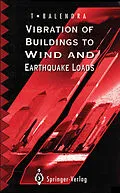Recent advances in the development of high strength materials, coupled with more advanced computational methods and design procedures, have led to a new generation of tall and slender buildings. These structures are very sensitive to the most common dynamic loads; wind and earthquakes. The primary requirement for a successful design is to provide safety while taking into account serviceability requirements. This book provides a well-balanced and broad coverage of the information needed for the design of structural systems for wind- and earthquake-resistant buildings. It covers topics such as the basic concepts in structural dynamics and structural systems, the assessment of wind and earthquake loads acting on the system, the evaluation of the system response to such dynamic loads and the design for extreme loading. The text is generously illustrated and supported by numerical examples and will be of great interest to practising engineers and researchers in structural, civil and design engineering and also to architects. The author has drawn on his experience as a teacher, researcher and consultant.
Inhalt
1 Fundamentals of Structural Dynamics.- 1.1 Introduction.- 1.2 One-degree-of-freedom System.- 1.2.1 Equation of Motion.- 1.2.2 Free Vibration.- 1.2.3 Response to Harmonic Loading.- 1.2.4 Response to Arbitrary Loading.- 1.3 Multi-degree-of-freedom System.- 1.3.1 Equation of Motion.- 1.3.2 Undamped Free Vibration.- 1.3.3 Forced Vibration Response.- 1.4 Continuous System.- 1.4.1 Equation of Motion.- 1.4.2 Free Vibration.- 1.4.3 Orthogonality of Modes of Vibration.- 1.4.4 Forced Vibration Response.- 2 Behaviour of Buildings Under Lateral Loads.- 2.1 Structural Systems.- 2.1.1 Braced Frame Structures.- 2.1.2 Rigid Frame Structures.- 2.1.3 Shear Wall Structures.- 2.1.4 Shear Wall-Frame Structures.- 2.1.5 Framed Tube Structures.- 2.1.6 Tube in Tube Structures.- 2.1.7 Bundled Tube Structures.- 2.1.8 Outrigger-braced Structures.- 2.2 Modelling of Structural Systems.- 2.2.1 Behaviour of Buildings.- 2.2.2 Modelling of Plane Structures.- 2.2.3 Modelling of Three-dimensional Structures.- 2.2.4 Reduction of Size of Model.- 3 Dynamic Effects of Winds on Buildings.- 3.1 Characteristics of Wind.- 3.1.1 Mean Wind Speed.- 3.1.2 Turbulence.- 3.1.3 Integral Scales of Turbulence.- 3.1.4 Spectrum of Turbulence.- 3.1.5 Cross Spectrum of Turbulence.- 3.2 Wind-induced Dynamic Forces.- 3.2.1 Forces due to Uniform Flow.- 3.2.2 Forces due to Turbulent Flow.- 3.3 Along-wind Response.- 3.3.1 Point Structures.- 3.3.2 Line-like Structures.- 3.3.3 Evaluation of Peak Response.- 3.4 Across-wind Response.- 3.5 Torsional Response.- 3.6 Serviceability Requirements.- 4 Wind Tunnel Studies of Buildings.- 4.1 Introduction.- 4.2 Rigid Model Studies.- 4.3 Aeroelastic Model Studies.- 4.3.1 Aeroelastic Model with Linear Mode (Semi-rigid Model).- 4.3.2 Aeroelastic Model with Shear-Flexure Mode.- 4.3.3 Aeroelastic Model with Coupled Modes.- 4.4 High-frequency Force Balance Model.- 4.5 Pedestrian Wind Studies.- 5 Analysis of the Behaviour of Buildings During Earthquakes.- 5.1 Earthquake Loading.- 5.2 Response Spectrum Analysis of SDOF.- 5.3 Response Spectrum Analysis of MDOF.- 5.4 Site and Soil-Structure Interaction Effects.- 5.5 Equivalent Lateral Load Analysis.- 5.6 Inelastic Response Analysis.- 6 Earthquake-resistant Design of Buildings.- 6.1 Desigft Philosophy.- 6.2 Structural Configuration.- 6.2.1 Vertical Configuration.- 6.2.2 Horizontal Configuration.- 6.3 Steel Structures.- 6.3.1 Moment-Resisting Frame (MRF).- 6.3.2 Concentrically Braced Frame (CBF).- 6.3.3 Eccentrically Braced Frame (EBF).- 6.3.4 Knee-Brace-Frame (KBF).- 6.3.5 Applications.- 6.4 Concrete Structures.- 6.4.1 Moment-resisting Frames.- 6.4.2 Shear Wall Structures.- 6.4.3 Coupled Shear Walls.
